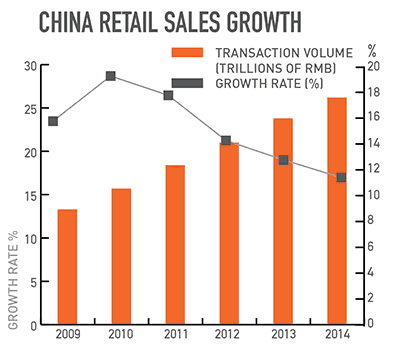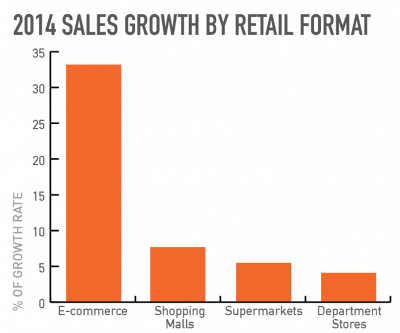
China’s retail sales are still growing, but the expansion rate has slowed each year since 2010
This post is part of a series highlighting content in Mingtiandi’s China Mall 2020 white paper. Find out more about this retail research report here.
Retail brands hoping to expand in China may have been taken heart this month when Premier Li Keqiang underlined the country’s commitment to shifting towards a consumption-based economy, however, many companies are already scaling back once ambitious expansion plans for the mainland.
In many ways Li’s vision of a shift towards consumer spending is already happening, with retail sales beating analysts estimates last month with a 10.8 percent rise compared to August last year.
However, for retailers that feasted on China’s rapid growth of last decade, the current climate may still seem inhospitable, as sellers of clothes, luxury goods and even groceries struggle to compete in an increasingly competitive local landscape.
As part of its research for the China Mall 2020 report, Mingtiandi looked into the strategies that many companies are taking to win in the current climate, and found that effective application of marketing technologies may hold the key to retail success on the mainland.
Did E-Commerce Succeed, or Did Offline Commerce Stumble?

The growth of e-commerce has outstripped other retail formats
Among the biggest success stories of China retail has been the booming growth in the country’s e-commerce sector.
Since Jack Ma kicked things off with Taobao in 2003, China’s online retail sales have grown to the extent that in 2013 the country surpassed the US to become the world’s largest e-commerce market with sales in excess of US$300 billion annually.
However, while some of this success is due to the convenience of shopping online, consumers have also been attracted to e-commerce because of its more efficient, demand-driven retail experiences, particularly compared to a domestic off-line retail sector where customer service and the shopping experience remain mired in decade-old SOE thinking.
Learning From the Successes of E-Commerce

Daryl Ho of digital consultancy Zeno Group
Fortunately for operators of traditional stores, China is also leading the way in adoption of smart phones and mobile commerce, giving retail brands that rely on sales in the mall the opportunity to collect data on consumer preferences and refine their retail processes in much the same way that online merchants have.
“The central responsibility of the retailer, whether it’s an online retailer or an offline retailer or an omnichannel retailer, is to really understand what that customer journey is,” David Ketchum, CEO of digital marketing consultancy Current Asia. “There’s an amazing toy chest of technologies and platforms and media but at the centre of all of this is really that customer journey.”
The digital tools available to retailers, as well as to mall operators, include resources as simple as corporate WeChat accounts and more high tech options such as Apple’s iBeacon systems that enable retailers to broadcast messages to shoppers via Bluetooth, and analyse customer behavior inside and outside of their stores.
According to Daryl Ho, Managing Director for China at Digital PR agency Zeno Group, the fashion industry and big- box electronics stores are among the more aggressive industry players in upgrading their retail environments with such technologies as motion and heat sensors, iBeacons, infrared, and mobile tracking software.
Such technologies help retailers analyse shopping behaviour and gather intelligence about the touch-points consumers make during their shopping experiences.
In China’s more competitive retail environment, making use of this analytic data can be a critical advantage to retailers seeking to tune their operations and improve profitability as they expand.
WeChat Helping Brands Connect with Consumers
And retail brands are already taking advantage of China’s world-leading rates of mobile adoption to make contact with customers and pull more shoppers into their stores.
According to a recent survey by digital research agency L2, 44 percent of retail brands in China are using Tencent’s popular WeChat platform to connect with their customers.
And this use of mobile media is already turning into offline sales. A recent WeChat campaign by fashion brand Tommy Hilfiger led to a 21 percent increase in sales at the company’s Beijing stores.
Designing Malls for China’s Digital Future
Digital tools such as WeChat are proving useful not just to retail brands, but also to developers and operators of mainland shopping malls.

Feature ceilings, such as this example at Shanghai’s iAPM mall, are part of high tech mall design
Connecting with customers via social platforms and apps are giving managers of China’s shopping centres new levels of data on shoppers’ habits and the routes they take on their shopping journeys. This kind of advantage can be critical in a market where property consultancy JLL estimates 40 million square metres of new malls will come online in the next three years.
Mall operators can facilitate the gathering of this analytic data by building new technical infrastructure into their projects, and this is already changing mall designs.
One aspect that is increasingly changing in design in the digital age is the use of ceiling, floor, and wall space for interactive displays, notes Christine Lam, Executive Director with international design consultancy Aedas. Where once skylights were a favoured design, digital requirements increasingly mean ‘feature ceilings’ are now being used to host technical equipment such as wireless routers.
But incorporating such elements requires deeper integration between physical architects and technical team members.
“When designing a mall you should have your physical architect design it but you should also have your IT architect to sit down with the actual structural architect at the initial stages to actually be able to integrate technology into every single facet of the mall because the way that people interact with the mall these days – they’re trying more digital and more online,” says James Macdonald head of research for China with Savills.
Use of the ceiling is a new way of utilising space in the mall for new technological advancements. This emphasises why designers are so focused on flexibility in their designs, meaning they have capacity to absorb other innovations.
The ability of mall developers to incorporate new technology and innovative design techniques into their shopping centres can be the determining factor in creating a successful project in China’s more competitive retail environment in the next five years. However, the rapid construction of new malls also means that the mainland has the opportunity to have some of the most modern malls of any of the world’s major retail markets by 2020, if not before.
China Mall 2020 is sponsored by Taubman Asia. For more information about the project, or to download the full report, just click here.
Leave a Reply